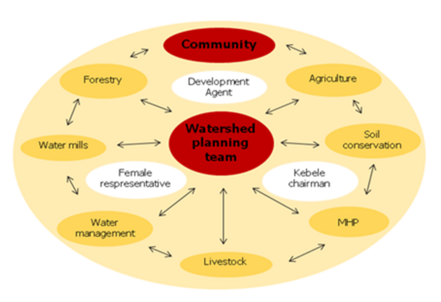Click here to register!
Difference between revisions of "Watershed Planning Team related to Micro-hydro Power (MHP) Projects in Ethiopia"
***** (***** | *****) m |
***** (***** | *****) m |
||
| Line 1: | Line 1: | ||
| − | == Participatory Approach | + | == Participatory Approach == |
| − | People’s participation is of great importance in order to successfully establish and implement [[Environment Assessment and Watershed Action Planning related to MHP|Environment Assessment and Watershed Action Planning]]. Taking into account people’s needs helps to increase acceptance and thus their willingness to invest in long term conservation<ref>DARGHOUTH, S. et al. (2008): Watershed Management Approaches, Policies, and Operations: Lessons for Scaling Up. In: Water Sector Board Discussion Paper Series, 11.</ref>. Hence | + | People’s participation is of great importance in order to successfully establish and implement [[Environment Assessment and Watershed Action Planning related to MHP|Environment Assessment and Watershed Action Planning]]. Taking into account people’s needs helps to increase acceptance and thus their willingness to invest in long term conservation<ref>DARGHOUTH, S. et al. (2008): Watershed Management Approaches, Policies, and Operations: Lessons for Scaling Up. In: Water Sector Board Discussion Paper Series, 11.</ref>. Hence all stakeholders and the watershed community (ies) should be involved in ''all steps ''of the [http://energypedia.info/index.php/Watershed_Action_Planning_related_to_MHP_projects_in_Ethiopia#Community_involvement_in_the_planning_process planning] and [http://energypedia.info/index.php/Watershed_Action_Planning_related_to_MHP_projects_in_Ethiopia#Implementation implementation] as well as the [http://energypedia.info/index.php/Watershed_Action_Planning_related_to_MHP_projects_in_Ethiopia#Participatory_monitoring_and_evaluation monitoring and evaluation process]. |
| − | |||
| − | |||
| − | + | == Identification of Stakeholders == | |
| − | + | In order to successfully implement a participatory approach, various disciplines need to be involved. Firstly a watershed planning team should be established that includes representatives from both, various disciplines and different levels of administration. The head of the team should be the ward’s '''Development Agent (DA)'''. Secondly, it is recommended that Stakeholders from forestry, soil conservation, agriculture and livestock be involved. In addition to this water management (water harvesting and irrigation), water mill and MHP representatives should be part of the team. If those representatives cannot be found in the ward(s), they should be assigned by the district's rural development office. Against the above backdrop it is essential to also consider [[:file:Ames-e energy and gender notes2010.pdf|gender issues]], which is why it is important to have at least one female team member. Finally the ward’s chairman should be part of the team<ref>DESTA, L. ET AL. (2005): Part 1: Community Based Participatory Watershed Development: Annex. Addis Ababa: Ministry of Agriculture and Rural Development.</ref><ref name="null">SCHNITZER, V. (2009) (unpublished): Micro Hydro Power Scout Guide: A Field Worker’s Manual.[[Media:Hydro scout guide ET may10.pdf ]]</ref>. | |
| − | < | + | [[File:Watershed Planning Team.png|center|441x302px|Watershed Planning Team.png]] |
| + | <p style="text-align: center"> '''Organizational Diagram of Watershed Planning Team'''</p> | ||
| − | |||
| − | + | If there is more than one ward in a watershed, representatives from each ward should be part of the planning team (at least each ward’s DA and chairman) to represent [[Points of conflict related to MHP projects in Ethiopia|possibly varying interests]]. | |
| − | |||
| − | [[Category: | + | |
| + | == References == | ||
| + | |||
| + | <references /> | ||
| + | |||
| + | [[Category:Ethiopia]] | ||
| + | [[Category:Hydro]] | ||
Revision as of 14:10, 23 August 2012
Participatory Approach
People’s participation is of great importance in order to successfully establish and implement Environment Assessment and Watershed Action Planning. Taking into account people’s needs helps to increase acceptance and thus their willingness to invest in long term conservation[1]. Hence all stakeholders and the watershed community (ies) should be involved in all steps of the planning and implementation as well as the monitoring and evaluation process.
Identification of Stakeholders
In order to successfully implement a participatory approach, various disciplines need to be involved. Firstly a watershed planning team should be established that includes representatives from both, various disciplines and different levels of administration. The head of the team should be the ward’s Development Agent (DA). Secondly, it is recommended that Stakeholders from forestry, soil conservation, agriculture and livestock be involved. In addition to this water management (water harvesting and irrigation), water mill and MHP representatives should be part of the team. If those representatives cannot be found in the ward(s), they should be assigned by the district's rural development office. Against the above backdrop it is essential to also consider gender issues, which is why it is important to have at least one female team member. Finally the ward’s chairman should be part of the team[2][3].
Organizational Diagram of Watershed Planning Team
If there is more than one ward in a watershed, representatives from each ward should be part of the planning team (at least each ward’s DA and chairman) to represent possibly varying interests.
References
- ↑ DARGHOUTH, S. et al. (2008): Watershed Management Approaches, Policies, and Operations: Lessons for Scaling Up. In: Water Sector Board Discussion Paper Series, 11.
- ↑ DESTA, L. ET AL. (2005): Part 1: Community Based Participatory Watershed Development: Annex. Addis Ababa: Ministry of Agriculture and Rural Development.
- ↑ SCHNITZER, V. (2009) (unpublished): Micro Hydro Power Scout Guide: A Field Worker’s Manual.Media:Hydro scout guide ET may10.pdf




















